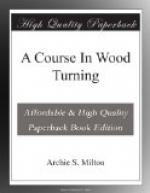CHAPTER VII
DUPLICATE TURNING
Under the head of duplicate turning have been classified only such models as clearly indicate the necessity of making two or more articles to complete the model or set of articles desired. But it is not intended to convey the idea that other models may not be made in duplicate as in many cases it is very desirable and even preferable that they should be made that way. Whatever the problem may be the suggestions offered at this point may be applied effectively.
Whenever two or more models are to be made identically alike there are always two possibilities of inaccuracies that will render the work dissimilar: First, inaccurate measuring both for length and points of new diameters and also on the new diameters themselves; second, a variation in the curved surfaces either on long convex or concave cuts.
The first difficulty can be overcome to a great extent by the use of a measuring stick. This stick should be made of any soft wood. It should be straight on one edge and about the thickness of an ordinary rule. On the straight edge lay off very carefully measurements for length, shoulders, beads, concaves and all points where calipering for new diameters will be necessary. Insert at each point measured a small brad which has been sharpened at both ends, leaving the end protrude about 1/8”. Care should be taken that all brads protrude the same distance.
After the stock has been turned to the largest diameter, the stick is held in the position of the rule while measuring and the points are forced against the revolving cylinder, thus scoring it. This stick can be used as many times as the model is to be made and the measurements will always be the same.
To avoid dissimilar curves it is well to cut out a full sized templet of the model to be made. This templet can be made of any thin, stiff material, preferably light sheet iron. In some cases it will be necessary to make the templet in several pieces in order to help facilitate the tool operations.
The use of this templet will not only be a help to getting all curved surfaces the same, but will also check up on the various new diameters on the model. The cylinder should never be in motion while the templet is being used.
CHAPTER VIII
FINISHING AND POLISHING
To get a high and lasting polish on wood, the work must be first sanded so as to be perfectly smooth. In addition to this, open grained wood, such as oak, must be properly filled with a wood filler. If properly sharpened tools have been used very little sanding is required, and then worn sandpaper should be used as it does not cut into the work as new paper cuts. Remember sandpaper is not to be used as a tool in cutting down stock when working to dimensions. In using old sandpaper run the lathe at a moderate speed to avoid burning the wood, especially on square or round fillets. Keep the edges of the work sharp and do not wear them round. In using new sandpaper use a fine grit (00 or 0) and move the paper from one end of the work to the other slowly, so that no scratches result on the surface of the work.




